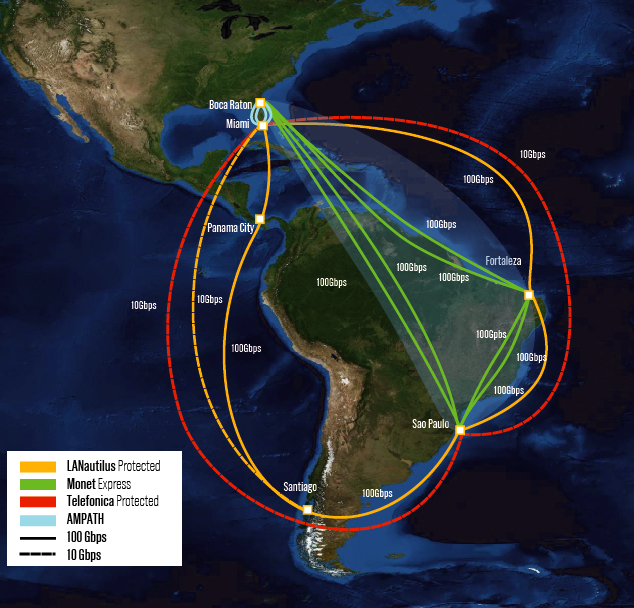AmLight Express and Protect project adds three 200Gbps optical waves for Research and Education between the U.S. and Brazil
Miami, Florida, August 30, 2019 – Florida International University (FIU), Rede Nacional de Ensino e Pesquisa (RNP), Academic Network of Sao Paulo (ANSP), the Association of Universities for Research in Astronomy (AURA), and Angola Cables are pleased to announce the addition of three 200Gbps optical waves for research and education between the U.S. and Brazil. These three 200Gbps optical waves represent the Express path of the AmLight Express and Protect (AmLight-ExP) project, a 5-year National Science Foundation (NSF) award to FIU (OAC-1451018), and with support from AURA, and the AmLight Consortium.
The Express path is built upon the Monet submarine cable system, linking the U.S. to Brazil, and operated by Angola Cables. The approach chosen to add these new optical waves was through the use of optical spectrum, where Angola Cables assigned a total of 150GHz over the Monet submarine cable system to be used by the AmLight Consortium. The AmLight Consortium uses the 150GHz spectrum to create three 200Gbps optical waves between Boca Raton, Fortaleza, and Sao Paulo. Each optical wave enables the use of two 100Gbps client ports. The Express path is represented in the figure by the solid green segments, where each segment represents a 100Gbps link from the 200Gbps optical wave; the Protect path is represented by the other segments in the figure that form a ring around South America.
The AmLight Consortium built the Express path using CIENA generated waves over the Subcom constructed optical spectrum, a nascent approach that will provide the AmLight Consortium with the flexibility of upgrading the bandwidth capacity as optical technology advances. The spectrum will be available to the research and education community at least until 2032. This is important for the Large Synoptic Survey Telescope (LSST), whose science mission will rely upon a robust network service that can provide the bandwidth that’s needed to transport 12.7 GB images within 5 seconds from the LSST Base site in La Serena, Chile to the archive site at the National Center for Supercomputing Applications (NCSA), in Urbana-Champaign Illinois for roughly 10 hours every night, 365 nights a year, over the 10 year period of the LSST survey. Starting in 2022, LSST will make about 1000 visits per night (and each visit includes 2 images) each night with its 3.2 billion pixel camera, recording the entire visible southern sky twice each week.
The combined Express and Protect paths form a path-diverse resilient high-performance network infrastructure, built to enable and support big science applications, such as astronomy and high-energy physics, operated by the AmLight Consortium. The AmLight Consortium members include Florida International University (FIU), the Academic Network of Sao Paulo (ANSP), the Rede Nacional de Ensino e Pesquisa (RNP) (Brazilian research and education network), the Red Universitaria Nacional (Reuna) (Chilean research and education network), the regional network of Latin America (RedCLARA), the Association of Universities for Research in Astronomy (AURA), Florida LambdaRail (FLR), Internet2, Telecom Italia Sparkle, and Angola Cables.
“The lighting of these waves is the culmination of a decade of work by the LSST international networking team and all the members of the AmLight Consortium. It is pioneering in both the public-private partnerships that enable it, as well as the novel flexible approach to submarine networking. It is an exciting time for the Research and Education Networking” Prof. Chip Cox, Co-Principal Investigator of the AmLight-ExP project.
“The addition of the Express path to AmLight-ExP provides unprecedented bandwidth capacity to the research and education communities in the Americas,” said Dr. Julio Ibarra, the Principal Investigator of the AmLight-ExP project.
“AURA is immensely gratified to see the hard work of this collaboration with the AmLight consortium paying off with this major milestone. The unique promise of LSST science, a real time view of the dynamic night sky, depends on the high speed network from Chile to the USA, and this completes a major part of it” added Robert Blum, Director for LSST Operations.
According to Eduardo Grizendi, Director of the Directorate of Engineering and Operations of the Brazilian academic network RNP, “In addition to the benefits that Express Path brings to the entire academic community of the Americas, it should be noted that it also consolidates the successful partnership around AmLight Consortium built upon the Monet submarine cable system.”
“We are very proud and excited at being an active participant in this far-reaching scientific research project as it represents the real potential and value that our submarine cable networks can contribute to the knowledge and understanding not just of the world we live in, but the many worlds that lie beyond our solar system,” said Victor Costa, Angola Cables’ Regional Director, Brazil.
The Academic Network of Sao Paulo (ANSP) provides connectivity to more than fifty institutions, which are responsible for more than forty percent of Brazilian science production. The AmLight Consortium implementation of the AmLight Express network is a major milestone for the project underpinned by our partnership with RNP and FIU for 15+ years.
